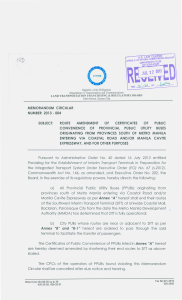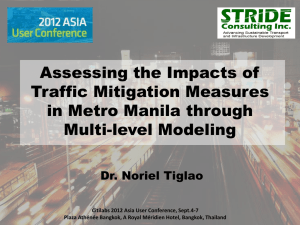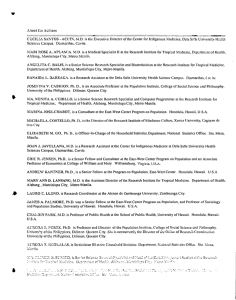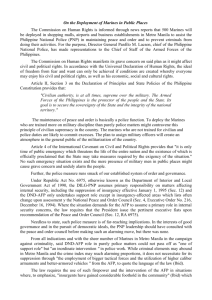metro manila - East
advertisement
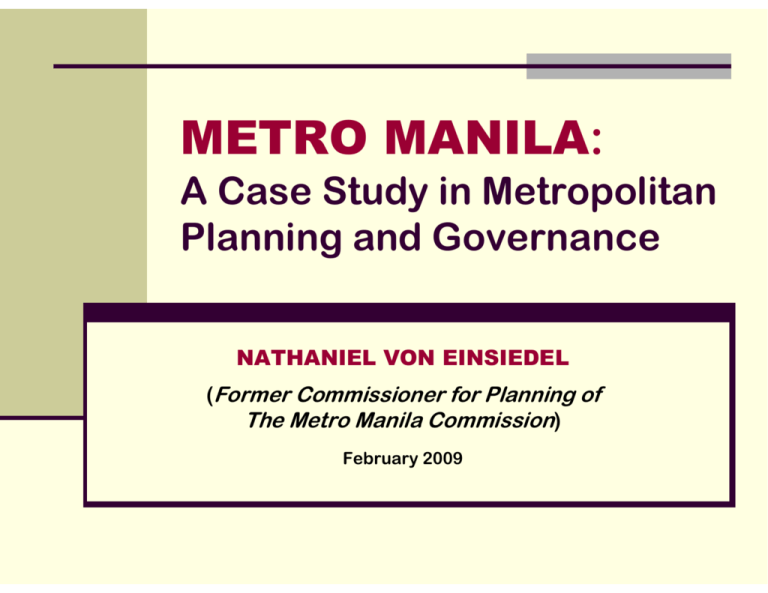
METRO MANILA: A Case Study in Metropolitan Planning and Governance NATHANIEL VON EINSIEDEL (Former Commissioner for Planning of The Metro Manila Commission) February 2009 INTRODUCTION Location of Metro Manila INTRODUCTION The Metro Manila Area Component Local Governments 1. 2. 3. 4. 5. 6. 7. 8. 9. 10. 11. 12. 13. 14. 15. 16. 17. Manila Quezon Caloocan Pasay Makati Paranaque Las Pinas Muntinlupa Taguig Pateros Pasig Marikina Mandaluyong San Juan Navotas Malabon Valenzuela INTRODUCTION Basic Information Premier urban center Center of government, trade, commerce, finance, education, and culture Total Land Area: 636 sq. km. Total Population: 11,553,427 Population Density: 18,650 Annual Population Growth Rate: 2.11% Per Capita Income: P67,290 Contribution to GNP: 32% INTRODUCTION Origins of Metro Governance Urban problems such as poverty, inadequate housing, proliferation of slum areas, water shortage, flooding, traffic congestion, uncollected garbage, and increasing crime were perceived to have reached critical levels in mid-1960s. By late-1960s, there were many proposals from various sectors suggesting the establishment of a metropolitan governance and planning system. In 1968, the Metro Manila Mayors Coordinating Council was organized as a voluntary organization of the 17 cities and towns comprising what was then called the ‘Greater Manila Area’. It existed for six years, accomplishing nothing. In 1972, then President Ferdinand Marcos declared Martial Law, and in 1975 created the Metro Manila Commission (MMC). RATIONALE FOR CREATING THE MMC (1975) Problems in Metro Manila had reached critical levels, and attempts by the individual towns and cities to solve these have been failures. These problems are too large, complex and widespread for individual towns and cities to solve. They don’t have the necessary financial resources, manpower and equipment. National government has the whole country to take care of, especially regions which are much poorer than Metro Manila. Most of the problems faced by Metro Manila’s towns and cities went beyond their traditional jurisdictional boundaries. FUNCTIONS OF THE MMC 1. To act as a central government to establish, administer and provide services common to the Metro Manila Area; 2. To perform general administration, executive and policy-making functions; 3. To establish a garbage disposal operations center which shall direct garbage collection and disposal in the metro area; 4. To establish and operate a transport and traffic center which shall direct traffic management activities; FUNCTIONS OF THE MMC (con’t.) 5. To coordinate and monitor governmental and private activities pertaining to essential services such as transport, flood control and drainage, water supply and sewerage, housing, health and environmental services, park development, and others; 6. To ensure and monitor the undertaking of a comprehensive social, economic and physical planning and development of the metro area; and 7. To study the feasibility of increasing barangay participation in their respective local governments. MMC’s ORGANIZATIONAL STRUCTURE OPERATING UNITS: COMMISSION OFFICERS Governor / Chairman Vice Governor Commissioner for Planning Commissioner for Finance Environmental Sanitation Commissioner for Operations Center Traffic Operations Center Barangay Operations Center Engineering Operations Center Action Center for Infrastructure Development Health Operations Center Cultural Affairs Office Others (Action Officers, each one corresponding to a “basic need”) ISSUES AGAINST THE MMC (1982) That MMC never accomplished its mandated tasks That MMC had not solved the problems for which it was created to solve That it had usurped the powers and functions of the local government units comprising the Metro Manila Area That it was overstaffed with political appointees That it continued to maintain offices which were created for special time-bound projects that had already been completed That what it claims as its accomplishments (e.g., housing, flood control, etc) were actually implemented by national government agencies ATTEMPTS TO REFORM THE MMC (1983-85) Internal recommendations from the Office of the Commissioner for Planning (1983-84) recommending, inter alia, the repeal of PD which gave Mrs. Marcos sole authority to act on behalf of the MMC; activate the MMC as a true Commission; and redefine its roles, powers, functions, and relationships with other government units. Recommendations of the University of the Philippines Law Center (1985), basically the same as above. All these recommendations were not implemented as the People Power Revolution of 1986 overthrew the Marcos administration and installed Mrs. Corazon Aquino as President. REFORMS UNDER THE AQUINO ADMINISTRATION (1986-1992) Adoption of a new Constitution in 1987 with a specific provision on the creation by Congress of metropolitan political subdivisions whose jurisdiction “shall be limited to basic services requiring coordination.” The same provision also states that “The component cities and municipalities shall retain their basic autonomy and shall be entitled to their own local executives and legislative assemblies.” Repeal of the law creating the MMC and transforming it into the Metro Manila Authority (MMA) with the Mayors’ Council as the decision-making body but chaired by a Chairman appointed by the President. But the MMA retained all the offices that existed under the MMC, as almost all the politicians were busy preparing for elections. It was business as usual. REFORMS UNDER THE RAMOS ADMINISTRATION (1992-1998) Passage of the 1991 Local Government Code, giving local authorities more powers, wider authority, and additional sources of revenues. This further weakened the MMA and sparked the filing of several bills in Congress to abolish the MMA and replace it with something more relevant. In 1995, RA 7924 was passed abolishing the MMA and replacing it with the Metro Manila Development Authority (MMDA), with a Chairman (with the rank of a Cabinet member) who is appointed by the President serving as CEO, and the Metro Manila Mayors’ Council as the governing and policy-making body. REPUBLIC ACT 7924 Continued to recognize the special and unique situation and circumstances of the Metro Manila area. Treats the metropolis as a special development and administrative region, but without prejudice to the autonomy of the affected local authorities. Provides MMDA with the responsibility for planning, monitoring and coordination, and exercise of regulatory and supervising authority over the delivery of metropolitan-wide services within the metropolis. Makes a distinction that purely local matters are the concern of the local authorities and therefore are outside the MMDA’s scope of authority REPUBLIC ACT 7924 Defines metropolitan-wide services to be those which have metropolitan-wide impact and transcend local political boundaries, or entail huge expenditures such that it would not be viable for these services to be provided by the individual local authorities. These services are: 1. Development planning for the metropolitan area 2. Transport and traffic management 3. Solid waste disposal and management 4. Flood control and sewerage 5. Urban renewal, zoning and land use planning, and shelter services 6. Health and sanitation, urban protection and pollution control 7. Public safety, including disaster preparedness, prevention, rescue operations, and rehabilitation IN REALITY . . . The MMDA Chairman has difficulties convening a quorum for the meetings of the Mayors’ Council. The MMDA has become ineffective in development planning of the metropolitan area. Among its several mandated functions, it is mainly focused on 1) transport and traffic management; 2) solid waste disposal; and 3) flood control. Some local authorities in the metropolis do not implement or enforce the policies of the MMDA. CONCLUSIONS In the context of the Philippine political and public management system, there is an inherent conflict between metropolitan governance and local government autonomy. To the Mayors of local authorities comprising the Metro Manila area, their primary and full-time concern is their constituency. Their participation in the affairs of the Metro Manila Mayors’ Council is secondary and part-time. The differentiation between “metropolitan-wide services” and “purely local matters” is contentious since metropolitan-wide services invariably have local components. A metropolitan governance system needs to be reviewed regularly (say, every 5 years), and reformed accordingly. Thank you for your attention.
